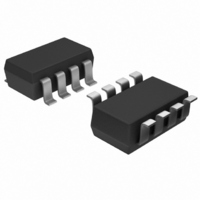MAX3374EEKA+T Maxim Integrated Products, MAX3374EEKA+T Datasheet - Page 13

MAX3374EEKA+T
Manufacturer Part Number
MAX3374EEKA+T
Description
IC LVL XLTR LV 8MBPS SOT23-8
Manufacturer
Maxim Integrated Products
Datasheet
1.MAX3373EEKAT.pdf
(31 pages)
Specifications of MAX3374EEKA+T
Logic Function
Translator, Unidirectional, 3-State, Open Drain
Number Of Bits
2
Input Type
Logic
Output Type
Logic
Data Rate
16Mbps
Number Of Channels
2
Number Of Outputs/channel
1
Differential - Input:output
No/No
Propagation Delay (max)
15ns
Voltage - Supply
1.65 V ~ 5.5 V
Operating Temperature
-40°C ~ 85°C
Package / Case
SOT-23-8
Supply Voltage
1.65 V ~ 5.5 V
Lead Free Status / RoHS Status
Lead free / RoHS Compliant
As with all Maxim devices, ESD-protection structures are
incorporated on all pins to protect against electrostatic
discharges encountered during handling and assembly.
The I/O V
electricity. Maxim’s engineers have developed state-of-
the-art structures to protect these pins against ESD of
±15kV without damage. The ESD structures withstand
high ESD in all states: normal operation, three-state
output mode, and powered down. After an ESD event,
Maxim’s E versions keep working without latchup,
whereas competing products can latch and must be
powered down to remove latchup.
ESD protection can be tested in various ways. The I/O
V
protection to the following limits:
1) ±15kV using the Human Body Model
2) ±8kV using the Contact Discharge method specified
3) ±10kV using IEC 1000-4-2’s Air-Gap Discharge
ESD performance depends on a variety of conditions.
Contact Maxim for a reliability report that documents
test setup, test methodology, and test results.
Figure 3a shows the Human Body Model and Figure 3b
shows the current waveform it generates when dis-
charged into a low impedance. This model consists of
a 100pF capacitor charged to the ESD voltage of inter-
est, which is then discharged into the test device
through a 1.5kΩ resistor.
Figure 3a. Human Body ESD Test Model
CC
±15kV ESD-Protected, 1µA, 16Mbps, Dual/Quad
VOLTAGE
SOURCE
in IEC 1000-4-2
method
HIGH-
DC
lines of this product family are characterized for
CHARGE-CURRENT-
CC
LIMIT RESISTOR
lines have extra protection against static
R
C
1MΩ
100pF
C s
______________________________________________________________________________________
Low-Voltage Level Translators in UCSP
STORAGE
CAPACITOR
R
RESISTANCE
D
DISCHARGE
1500Ω
±15kV ESD Protection
ESD Test Conditions
Human Body Model
DEVICE-
UNDER-
TEST
The IEC 1000-4-2 standard covers ESD testing and
performance of finished equipment; it does not specifi-
cally refer to integrated circuits. The MAX3372E–
MAX3379E and MAX3390E–MAX3393E help to design
equipment that meets Level 3 of IEC 1000-4-2, without
the need for additional ESD-protection components.
The major difference between tests done using the
Human Body Model and IEC 1000-4-2 is higher peak
current in IEC 1000-4-2, because series resistance is
lower in the IEC 1000-4-2 model. Hence, the ESD with-
stand voltage measured to IEC 1000-4-2 is generally
lower than that measured using the Human Body Model.
Figure 4a shows the IEC 1000-4-2 model, and Figure 4b
shows the current waveform for the ±8kV, IEC 1000-4-2,
Level 4, ESD contact-discharge test.
The air-gap test involves approaching the device with a
charged probe. The contact-discharge method con-
nects the probe to the device before the probe
is energized.
The Machine Model for ESD tests all pins using a
200pF storage capacitor and zero discharge resis-
tance. Its objective is to emulate the stress caused by
contact that occurs with handling and assembly during
manufacturing. Of course, all pins require this protec-
tion during manufacturing, not just inputs and outputs.
Therefore, after PCB assembly, the Machine Model is
less relevant to I/O ports.
Figure 3b. Human Body Current Waveform
AMPERES
I
P
36.8%
100%
90%
10%
0
0
t
RL
CURRENT WAVEFORM
TIME
t
DL
I r
PEAK-TO-PEAK RINGING
(NOT DRAWN TO SCALE)
Machine Model
IEC 1000-4-2
13











